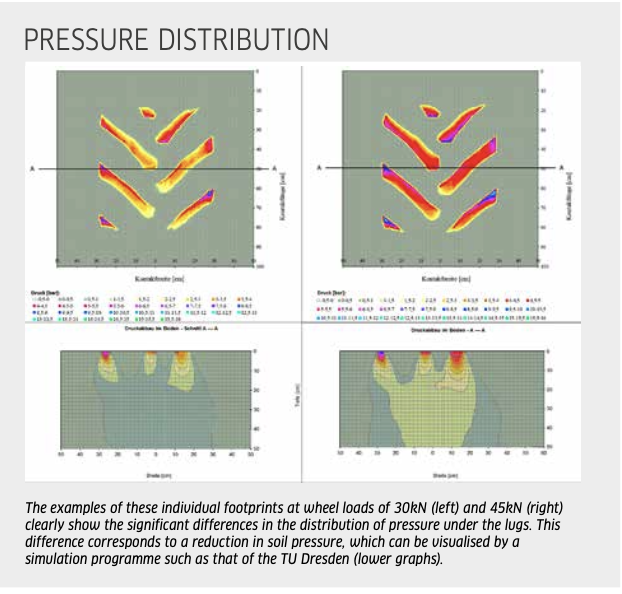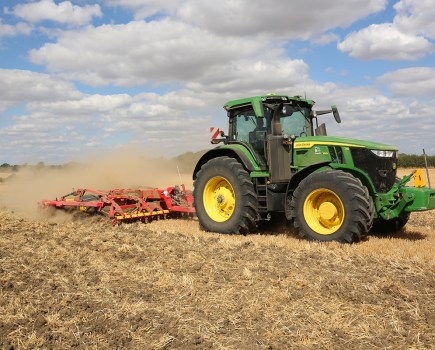PRACTICAL TEST: Almost all tractor tyre manufacturers now have a standard and VF design. We had both types tested by the Technical University of Dresden in our exclusive test.
To be clear, this is not a comparison that looks at all of the aspects of a tyre and then helps to make a buying decision. To do that, we would also need to include aspects such as the capability to get power onto the ground, ride comfort when on the road, durability and purchase price. Depending on the workload, these factors would have different degrees of importance when making a final buying decision.
Instead, with this comparison, we are only providing an initial overview of what modern tyres are capable of in terms of deflection and contact area. The TU Dresden supported us by making the measurements on their test bench, more details of which appear on the following page in “How the measurements were taken”.
The test candidates
We submitted the following 650/65 R42 tyres to the test:
● Alliance Agristar 365 Standard and Agristar 365 Agriflex
● BKT Agrimax RT657 and Agrimax V-Flecto
● Ceat Farmax R65 and Torquemax
● Michelin Multibib, Multibib Plus and Axiobib2
● Trelleborg TM800 and TM1000 PT
● Vredestein Traxion 65 and Optimall
Michelin supplied the Multibib and Multibib Plus, because standard tyres are available with various weight bearing abilities. The Multibib (also the Trelleborg TM800 and the Vredestein Traxion 65) boasts a load/speed index of 158 D (max. 4,250kg wheel load rating at 65km/hr with 1.6 bar); the Multibib Plus and the standard tyres from BKT and Ceat come with a load/speed index of 165 D (5,150kg, 65km/hr, 2.4 bar). The Alliance Agristar even has 170 D (6,000kg, 65km/hr, 3.0 bar).
All of the VF standard tyres in the test (VF = Very High Flexion; VF always precedes the tyre size for instance VF 650/65 R42) have the even higher index 174 D, which indicates a load rating of 6,700kg at 65km/hr and only 2.0 bar pressure. This makes it clear how important the tyre pressure is for the comparison.
We worked with the different manufacturers to determine the recommended inflation pressure for each tyre based on the maker’s official tyre pressure tables.
The correct inflation pressure
For the test we assumed a wheel load of 30 or 45kN (which corresponds to around 3.0 or 4.5 tonnes per wheel) in continuous use when carrying out heavy draft work. Assuming a tractive force coefficient of 0.5, the specified wheel loads result in a tractive force of around 50kN with the 30kN wheel load (axle load distribution front/rear being 40:60) and around 75kN at 45kN wheel load. The tyre pressure should meet these demands.
The appropriate pressures are shown on the following page in the table “All of the results from our measurements at a glance”. Here you can see that the different manufacturer recommendations for standard tyres with a wheel load of 30kN vary between 0.6 bar (Vredestein) and 0.8 bar (Alliance, Ceat). For a 45kN wheel load, it’s only Alliance and Vredestein that go with 1.3 bar, while all the other manufacturers specify 1.4 bar.
Unlike standard tyres, VF tyres generally manage with an inflation pressure of just 0.6 bar for a wheel load of 30kN; only Alliance and Ceat specify 0.8 bar. For a 45kN wheel load, the recommendations vary between 0.9 bar (Michelin, Vredestein) and 1.0 bar (all of the others), so you can see that the range is much smaller here, highlighting the greater flexibility of VF tyres with an ultra-flexible carcass.
Ground pressure is a function of contact area
The footprint measurements produce a much more interesting insight. On the standard tyres, the contact width of the 650 tyres with a wheel load of 30kN ranges between 55cm (Michelin) and 60cm (BKT). This range hardly changes when the wheel load increases to 45kN; and it’s similar for the VF tyres.
But there is a much more notable difference in the length of the footprint: on standard tyres this ranged from 55cm (BKT) to 68cm (Trelleborg) at a wheel load of 30kN; for the more flexible VF tyres the measurements differ from 64cm (Alliance) to 70cm (Michelin). This results in considerable differences in the contact area. Contact patch comprises more than the pure lug area, because the tyres sink into the soil.
Great variations in contact length
At a wheel load of 30kN, the total footprint of the standard tyres ranges between just under 3,200cm2 (BKT) and slightly more than 3,600cm2 (Trelleborg). If wheel load increases to 45kN or by 50%, the total footprint even decreases (Michelin, Trelleborg, Vredestein) or remains almost the same (Alliance) due to the higher inflation pressure that is needed for some standard tyres.
If you compare the footprints of the VF tyres with each other, you’ll find that these are not necessarily larger than those of the standard tyres at a wheel load of 30kN. Only when the load increases can the VF tyres really show off their full potential thanks to the lower inflation pressure that these tyres can get away with.
Alliance Agriflex and the Michelin Axiobib have a footprint of more than 3,900cm2 at a wheel load of 45kN. By comparison, the Trelleborg TM1000 has a contact patch of just 3,655cm2. Converted to the average contact patch pressure, this makes a difference of almost 0.1 bar (1.15 to 1.24 bar).
VF advantage
The test results clearly show the distinct and practical working advantages of the more flexible VF tyres: on average, the contact pressure of all the tested brands is up to 0.2 bar lower than that of comparable standard tyres.
In addition, the VF tyres absorb the load much more effectively when the wheel load increases by 50% from 30 up to 45kN. The contact patch pressure increases by about 40% on average. In comparison, the standard tyres are very different, with contact patch pressure increasing disproportionately by 60%.
A separate and key issue to consider is how the pressure is distributed across the contact area. The graphs on the following pages show the footprint of each individual tyre. The differences are clear to see.
We will draw on these results later on when we simulate compaction. Both the Technical University of Dresden and Bern University of Applied Sciences in Switzerland have appropriate programmes (e.g. Terranimo), and an article on this is planned for a future issue of profi.

Unusual deflection
The overall footprint of the tyre increases as it deflects and, thanks to their more flexible carcasses, VF tyres provide more flex than standard tyres.
The measurements reveal that the amount of deflection varies to a significant degree. On the BKT Agrimax tyre, for example, the sidewall height was reduced by just 9cm from 38.8cm to 29.8cm. However, on the same firm’s V-Flecto it was by as much as 12cm from 39.7cm to 27.7cm. The Michelin Axiobib deflects by as much as 14cm at a wheel load of 45kN!
In practice, however, such high deflection is rarely accepted for fear of damaging the tyre. It just looks rather iffy. And then there is the ride stability, which naturally suffers when the tyres deflect that much and the tractor starts to wallow. This is why it is much better to change the tyre pressure when switching between field and road travel, preferably by using a tyre pressure control system.

Differences in rolling resistance
The rolling resistance is also interesting in this context. This resistance is the force that the tyre requires to roll at a specific wheel load on a paved surface. This force tends to be higher for all of the VF tyres due to their potentially lower inflation pressures (and therefore greater deformation of the carcass) than on a standard tyre.
However, if the rolling resistance is related to wheel load (rolling resistance coefficient), it quickly becomes clear that the specific rolling resistance decreases across the board as the wheel load increases due to the higher inflation pressure.
In any case, a higher rolling resistance value should not be overestimated, because it was measured on a smooth surface and with the tyre inflated to the lowest possible pressure. By comparison, when in the field, a tyre with a large contact patch would sink in less and therefore clearly have a much lower rolling resistance.
If you compare the standard tyres, you’ll find the Vredestein Traxion 65 with coefficients of 0.034 (at 30kN) and 0.024 (at 45kN) is heavier than, for example, Michelin’s Multibib Plus (0.026 and 0.019 respectively) — at least when on the road.
Among the VF tyres, the Ceat Torquemax has the lowest rolling resistance coefficients of 0.028 and 0.023 respectively; whereas the Vredestein Traxion Optimall is significantly higher with rolling resistance coefficients of 0.036 and 0.027.
Summary
An initial test bench comparison of standard low profile and VF tyres from the various makers shows the differences between the two designs. However, some of the brands also differ significantly in terms of rolling resistance, the size of the contact area and the pressure distribution across the contact patch. The results on pressure distribution will be referred to in a following article that will assess the level of soil compaction beneath the contact patch surface.
As mentioned at the start of this article, there are many other aspects to consider when comparing tyres. For example, the lugs on the Ceat Torquemax are only 45mm high, whereas the ones on the Michelin Axiobib measure 58mm.
As far as the total number of tread bars is concerned, the Axiobib only has 20 pairs, whereas the V-Flecto from BKT has 23 lugs. This may impact on the interlocking action of the tyre with the soil or its self-cleaning effects and the quality of the ride on the road. We didn’t look into these details. Lastly, the prices. Market prices differ widely. So, the prices published here were averaged from the prices we were given by UK dealers (unit price without VAT or fitment).
Ceat’s Farmax 65 is available for just £1,075, while the Michelin Multibib Plus, for example, costs more than twice as much at £2,425. The difference is even greater for VF tyres. In our survey, the Michelin Axiobib 2 is more than twice as expensive at €£3,015 as the Ceat Torquemax at just £1,425.
For more up-to-date farming news click here and subscribe now to profi and save.





